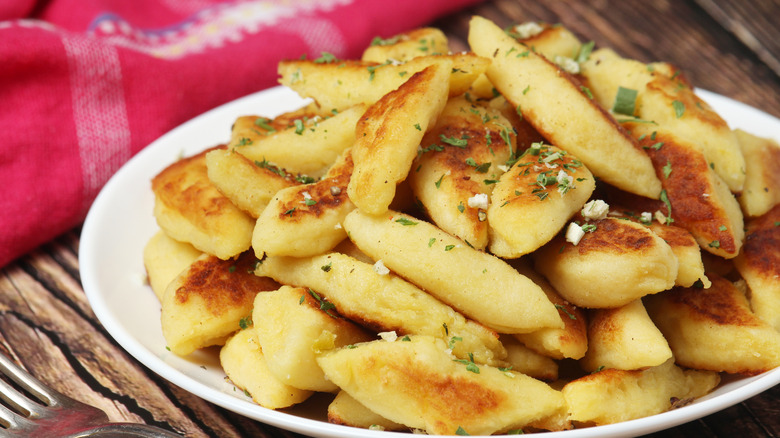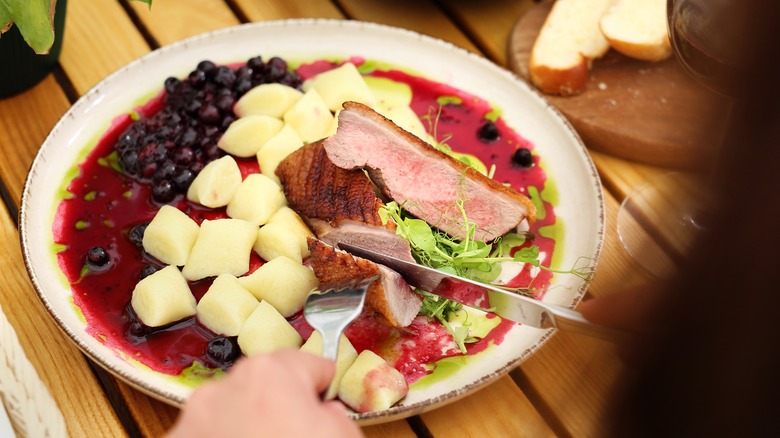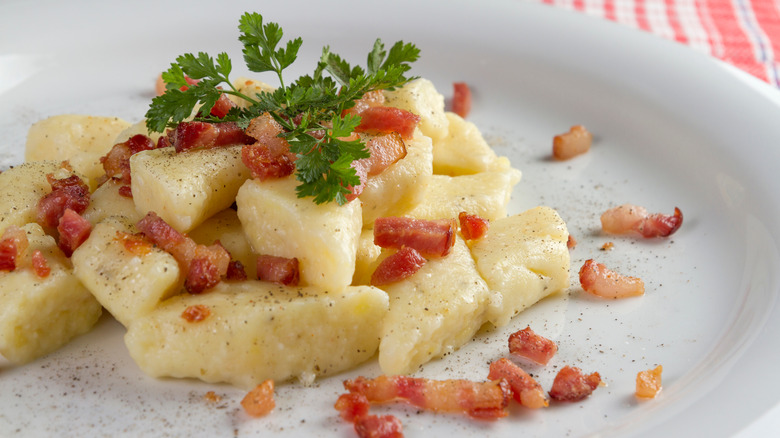Kopytka Are The Polish Potato Dumplings You Need On Your Radar
From fries to creamy soup, potatoes are wondrously versatile in their textural applications. Few cuisines highlight the full range of possibilities quite like Polish foods. Most meals involve the starchy tubular in some form, including fried, boiled, or roasted.
An especially tasty version of the food comes together as a dumpling. Called kopytka — or little hooves — these potato-based dumplings have a soft and slightly chewy consistency, similar in consistency to Italian gnocchi, and they boast an easy-to-love potato flavor. Crafting them requires only three ingredients but some specific know-how. However, nail the perfect texture, and their appeal's immediate — they make tremendous use of a potato's starch.
The dumplings are incredibly versatile, delicious on their own or with sweet and savory accompaniments. Traditionally, they're garnished with polonaise, a sauce made from melted butter and breadcrumbs. The exact pairings aren't strict; they'll meld with a variety of components, too. Let's dive into what goes into the Polish potato dish.
Components in kopytka
As a type of potato dumpling, no surprise that tubers are the dish's star ingredient. Take note that the color of the dumpling corresponds to the potato — as such vivid white varieties like Russet are preferred. Plus, this potato type contains more starch, which makes it easier to form and maintain the dumpling shape. To further bind the dish, kopytka's are formed with all-purpose flour, and an egg. Some salt and boiling water round out the ingredients necessary to prepare the dumpling's most basic version.
Although delicious on their own, a range of elements can also be used to top the dumplings. Common possibilities include frying the kopytkas in breadcrumbs and butter, lending them a crispy texture. Alternatively, the dumplings do well in a cream-based sauce alongside mushrooms, onions, and parsley. There's also a heartier version that integrates sauteed bacon, garlic, and onion. Once prepared, the dumplings are a canvas for many delicious flavors, so let's dive into how they come together.
How to make kopytka dumplings
Preparation starts by cooking the potatoes — the tastiest dumplings utilize freshly made tubers. Traditionally, they're boiled skin-on and then peeled, however, the potatoes can also be baked or air-fried to a soft consistency. While still warm, the root vegetable is then pressed through a potato ricer to shred. It's possible to make the dumplings by simply mashing the potatoes, although note it'll be tougher to nail the kopytka's smooth consistency.
Once ground, the potatoes are placed into a large bowl or flat surface. A single egg is folded in, alongside salt and enough flour to bind the mixture together. The dough's gingerly kneaded, with caution to not overwork, or else it'll turn too tough. Meanwhile, a pot of salted water is brought to a boil.
To shape the dumplings, the dough is rolled on a floured surface into a cylinder around half an inch thick. Using a sharp knife, it's then cut at a diagonal angle in inch-long increments. The procedure creates the characteristic trapezoidal shape. In small batches, the freshly cut dumplings are then boiled in the water. Kopytkas are ready a minute after they float to the surface.
What to serve with kopytka dumplings
The dumplings are often enjoyed on their own. However, much like gnocchi, they'll really pop when served with a few added components. To amplify their potato flavor with a crispy texture, melt butter in a pan and saute breadcrumbs until golden brown. Then, add the potato dumplings and cook until crispy.
For a more standalone dish, prepare the dumplings with fried garlic, onions, and mushrooms in a creamy sauce. Another option is to make them into a dessert by covering them in cinnamon and sugar and topping them with jam or whipped cream. The flavor of the dumpling itself can be altered too, by adding herbs like spinach or using a different potato type.
In Poland, the dumplings are often served alongside other classic dishes, like sauerkraut, sausages, and gravies. In an especially hearty rendition, they can be topped with Polish goulash. No surprise the dish is such a hit — finding an accompaniment is a breeze.



